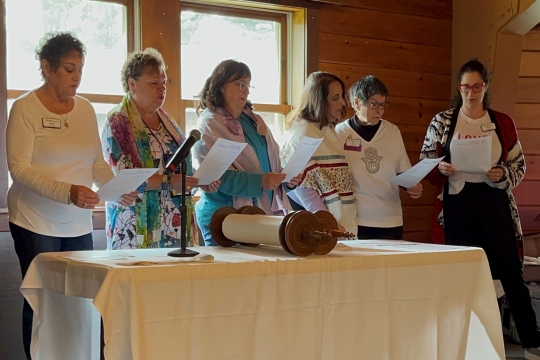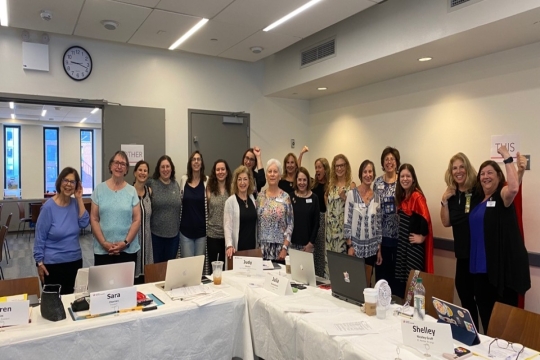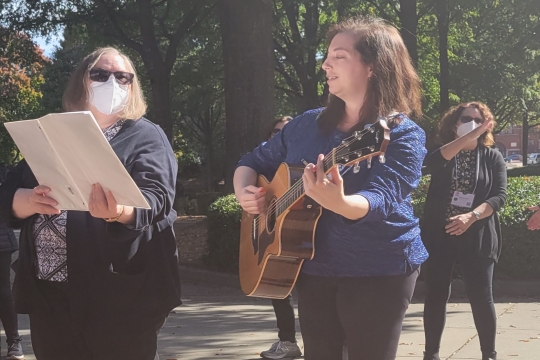by Connie Kreshtool
This week’s parashah, Sh’mini (“eighth”) opens with a description of the ritual occurring the day after the seven-day ordination ceremony of Aaron as High Priest. Moses instructs Aaron and his sons with specific directions for bringing offerings to the sanctuary to atone for sins that they or the people may have committed. After completing the purgation offering, the burnt offering and the offering of well-being Moses and Aaron bless the people. When fire erupts on the altar burning everything the people interpret this as a sign that God has accepted the priesthood.
What follows is the strange story of Aaron’s oldest sons, Nadab and Abihu who take pans, place “alien” fire and incense upon them, and offer them upon the altar. Immediately God sends fire that consumes them. This incident is seen as a sign of God’s awesome power but why it happens remains open to interpretation. Perhaps by acting on their own they, in essence, are challenging the system of laws and commandments that form that sacred community distinct from its neighbors.
For years when we read this parashah in my synagogue our rabbi, Herbert Drooz, would display a treasured piece from his collection of archaeological finds…a fire pan. It is amazing how real that made the reading.
Another major theme of this parashah is a listing of the foods that the people are permitted to eat and those that are forbidden. It is these lines on which the system of kashrut is built. Why did the Torah and subsequent Jewish law place so much emphasis on eating? Here again rabbis through the ages and to this day have offered different interpretations. The one that makes good sense to me is that observing kashrut set up boundaries and helped keep the Jewish community separate from its neighbors.
Early Reform Jews who sought to be part of the general community looked upon kashrut as a barrier they wanted to break down. In the 21st century, when American Jews are part of the general community, it is not surprising to learn that there are an increasing number of Reform Jews returning to “eating kosher” to proclaim their distinctiveness.
Food has always been a major part of any sisterhood program, whether for fundraising, socializing, educating, or donating. Many sisterhoods assembled their favorite recipes and issued cookbooks. I have quite a collection of cookbooks, gifts from sisterhoods who I visited while president of the National Federation of Temple Sisterhoods (now Women of Reform Judaism). As part of the WRJ Centennial, a call was issued for sisterhood cookbooks; that collection now resides in the American Jewish Archives in Cincinnati, OH. Reviewing the cookbooks I realized that over time sisterhoods have been eliminating from their recipes non-kosher meats, seafood, and the mixing of meat and dairy. Is it a return to tradition or a way to maintain some distinctiveness from our neighbors?
Connie Kreshtool is a WRJ past president and a member of the Sisterhood of Congregation Beth Emeth, Wilmington, DE.
Related Posts
Image

Parashat Yom Rishon shel Rosh HaShanah
September 14, 2023
During the High Holidays, my thoughts turn to the special blessings, prayers, and melodies that shape our journey from Selichot to Rosh HaShanah to the final shofar blast on Yom Kippur. Many of our prayers in the High Holiday liturgy are written in the plural.
Image

Cultivating a Culture of Accountability and Belonging
September 8, 2023
And, we’re off! Many of us have worked over the summer with friends and colleagues to set the calendar for the year ahead, including meetings, events, and other opportunities for gathering.
Image

My Journey from Altar-Girl to Cantorial Soloist
August 11, 2023
I was born a Goldman, and always knew I was Jewish on my dad’s side. Although my whole family was spiritual in their own way, the Jewish side of my family didn’t have warm feelings towards religion, and the only thing passed down to me was the Jewish humor I grew up in New Jersey and had an open...
